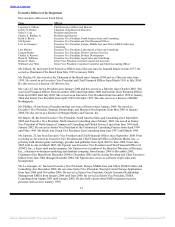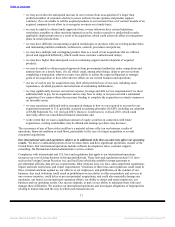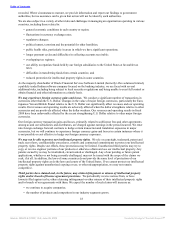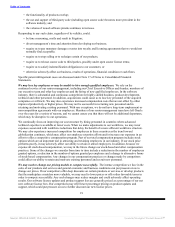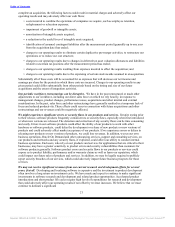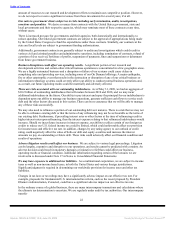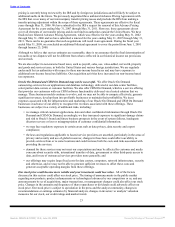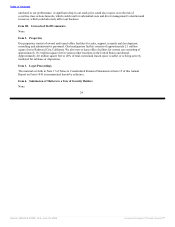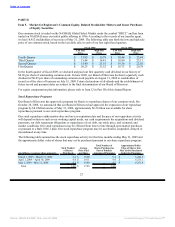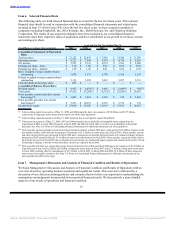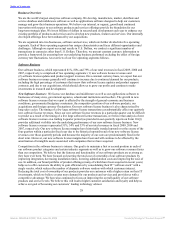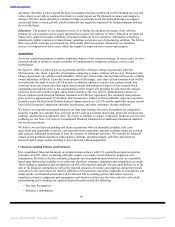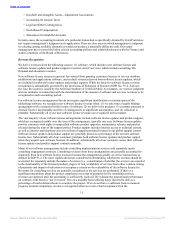Oracle 2008 Annual Report Download - page 26
Download and view the complete annual report
Please find page 26 of the 2008 Oracle annual report below. You can navigate through the pages in the report by either clicking on the pages listed below, or by using the keyword search tool below to find specific information within the annual report.
Table of Contents
complete an acquisition, the following factors could result in material charges and adversely affect our
operating results and may adversely affect our cash flows:
• costs incurred to combine the operations of companies we acquire, such as employee retention,
redeployment or relocation expenses;
• impairment of goodwill or intangible assets;
• amortization of intangible assets acquired;
• a reduction in the useful lives of intangible assets acquired;
• identification of assumed contingent liabilities after the measurement period (generally up to one year
from the acquisition date) has ended;
• charges to our operating results to eliminate certain duplicative pre-merger activities, to restructure our
operations or to reduce our cost structure;
• charges to our operating results due to changes in deferred tax asset valuation allowances and liabilities
related to uncertain tax positions after the measurement period has ended;
• charges to our operating results resulting from expenses incurred to effect the acquisition; and
• charges to our operating results due to the expensing of certain stock awards assumed in an acquisition.
Substantially all of these costs will be accounted for as expenses that will decrease our net income and
earnings per share for the periods in which those costs are incurred. Charges to our operating results in any
given period could differ substantially from other periods based on the timing and size of our future
acquisitions and the extent of integration activities.
Our periodic workforce restructurings can be disruptive. We have in the past restructured or made other
adjustments to our workforce, including our direct sales force on which we rely heavily, in response to
management changes, product changes, performance issues, acquisitions and other internal and external
considerations. In the past, sales force and other restructurings have generally resulted in a temporary lack of
focus and reduced productivity. These effects could recur in connection with future acquisitions and other
restructurings and our revenues could be negatively affected.
We might experience significant errors or security flaws in our products and services. Despite testing prior
to their release, software products frequently contain errors or security flaws, especially when first introduced
or when new versions are released. The detection and correction of any security flaws can be time consuming
and costly. Errors in our software products could affect the ability of our products to work with other
hardware or software products, could delay the development or release of new products or new versions of
products and could adversely affect market acceptance of our products. If we experience errors or delays in
releasing new products or new versions of products, we could lose revenues. In addition, we run our own
business operations, Oracle On Demand and other outsourcing services, support and consulting services, on
our products and networks and any security flaws, if exploited, could affect our ability to conduct internal
business operations. End users, who rely on our products and services for applications that are critical to their
businesses, may have a greater sensitivity to product errors and security vulnerabilities than customers for
software products generally. Software product errors and security flaws in our products or services could
expose us to product liability, performance and/or warranty claims as well as harm our reputation, which
could impact our future sales of products and services. In addition, we may be legally required to publicly
report security breaches of our services, which could adversely impact future business prospects for those
services.
We may not receive significant revenues from our current research and development efforts for several
years, if at all. Developing and localizing software is expensive and the investment in product development
often involves a long return on investment cycle. We have made and expect to continue to make significant
investments in software research and development and related product opportunities. Accelerated product
introductions and short product life cycles require high levels of expenditures for research and development
that could adversely affect our operating results if not offset by revenue increases. We believe that we must
continue to dedicate a significant
21
Source: ORACLE CORP, 10-K, June 29, 2009 Powered by Morningstar® Document Research℠




